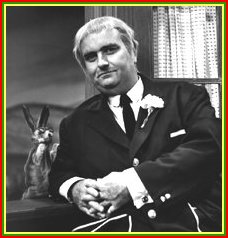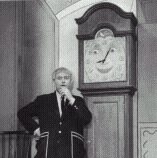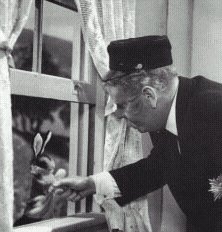|
|
Every morning Captain Kangaroo would come in the
Treasure House to the tune of it's theme song. When he
would hang his big ring of keys up the music stopped.
If The Captain would pick the keys back up......
the music began again until his keys were finally put on
the peg once and for all.
Who can forget Captain Kangaroo with his big pocketed coat
and the hundreds of ping pong balls falling from the ceiling
after one of Mr. Moose's knock knock jokes.
Life was good with Captain Kangaroo.
Mr. Green Jeans would come visit with all sorts of interesting
items including animals. Mr. Green Jeans loved animals and
tried to get his viewers to share that love for them.
Mr. Bunny Rabbit
with the big glasses would get scolded for
trying to steal carrots from the Captain or Mr. Green Jean's
garden. And seemed like he always was able to trick the
Captain into giving him his carrots.
Grandfather Clock with his sleepy face that would talk in
rhymes when he finally would wake up.
Captain Kangaroo was there for us, you and me. He spoke to
us, just like we were the only person in the world, just the
Captain and us.
The Captain Kangaroo Show wasn't a show, it was an experience,
a learning experience where you felt you belonged and
longed for to be physically with the Captain in his Treasure House.
Captain Kangaroo taught us valuable life lessons in a way that
we as small children could understand and relate to. He made
life and learning interesting for small children.
For Captain Kangaroo, the show and the man, it was about
making children important and showing them life ahead was
an adventure.

The Captain Kangaroo Show
The show ran on CBS from 1955 to 1985, and then moved
to public television for six more years. The show won six Emmys
and three Peabody Awards.
The format was simplicity itself: Keeshan would wander through
the Treasure House, wearing his distinctive big-pocketed coat,
and talk with Brannum and the puppets. He'd meet with guests,
tell stories, and generally entertain.
Shows were frequently interrupted with silliness, such as
hundreds of ping-pong balls dropping from the ceiling or Mr.
Moose's knock-knock jokes.

Show History & Philosophy
The CBS network was searching for innovative new approaches to
children's programming and approved the Kangaroo series submitted
by Keeshan and long-time friend Jack Miller. The series first
aired in October 1955 and continued until 1985, making it the
longest running children's series in network history. Keeshan not
only vividly embodied the Captain, but also played a central
creative role on the daily series, supervising and actively
contributing to the scripts and insuring the program's
conformity to his conceptions of appropriate children's entertainment.
Unlike many other children's programs, Captain Kangaroo
was not filmed before a studio audience and did
not include children in its cast. Keeshan wanted nothing that
would come between him and the children in his television
audience and so spoke directly to the camera. He also personally
supervised which commercials could air on the program, and
promoted products, such as Play-Dough and Etch-a-Sketch, which he
saw as facilitating creative play, while avoiding those he felt
purely exploitative.
Children learned most easily, he argued, when information and
knowledge became a source of delight. Keeshan's approach
represented a rejection of pressures towards the increased
commercialization of children's programming as well
as a toning-down of the high volume, slapstick style associated
with earlier kid show hosts, such as Pinky Lee, Soupy Sales and
Howdy Doody's Buffalo Bob.

Bob Keeshan
The mainstay of The Captain Kangaroo Show was the
grandfatherly Bob Keeshan.
"I was impressed with the potential positive relationship between
grandparents and grandchildren, so I chose an elderly character,"
Keeshan said.
In a statement issued by his son Michael, Keeshan's family said:
"Our father, grandfather and friend was as passionate for his
family as he was for America's children. He was largely a private
man living an often public life as an advocate for all that our
nation's children deserve."
"Captain Kangaroo" aired in the early mornings on CBS until 1985,
when the network canceled the show to expand its morning news
program.
Keeshan was named Broadcaster of the Year in 1979 by the
International Radio and Television Society and was inducted into
the National Association of Broadcasters Hall of Fame in 1998. He
also spent five years as the silent Clarabell the Clown on "The
Howdy Doody Show."
Keeshan was closely involved with health and child-care issues,
serving on several boards and working to provide child care to
the children of large corporations.
When Fred Rogers, the gentle host of "Mister Rogers'
Neighborhood," died last year, Keeshan recalled how they often
spoke about the state of children's programming.
"I don't think it's any secret that Fred and I were not very
happy with the way children's television had gone," Keeshan said.
Born in 1927 in suburban Long Island, the future Captain Kangaroo
grew up in Forest Hills, New York, and was an NBC page for his
last year of high school during World War II. He joined the
Marines after graduation.
Captain Kangaroo Show Cast
Captain Kangaroo: Bob Keeshan
Mr. Green Jeans: Hugh Brannum
Debbie: Deborah Weems
Dennis: Cosmo Allegretti
Mr. Baxter: James E. Wall
Banana Man: A. Robbins
Orville the Dragon: Terry Kelly
Mr. Moose
Bunny Rabbit
Miss Worm
Miss Frog
Dancing Bear
Grandfather Clock
Magic Drawing Board
Captain Kangaroo Theme Song:
"Puffin' Billy (The Captain Kangaroo Theme" by (music) Edward G.
White and (lyric) Mary Rodgers
More Fictional Rabbits
|